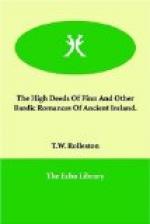In the next cycle we draw nearer to history, and are in the world not of myth but of legend. It is possible that some true history may be hidden underneath its sagas, that some of its personages may be historical, but we cannot tell. The events are supposed to occur about the time of the birth of Christ, and seventeen hundred years after those of the mythical period. This is the cycle which collects its wars and sorrows and splendours around the dominating figure of Cuchulain, and is called the Heroic or the Red Branch or the Ultonian cycle. Several sagas tell of the birth, the life, and the death of Cuchulain, and among them is the longest and the most important—the Tain—the Cattle Raid of Cooley.
Others are concerned with the great King Conor mac Nessa, and the most known and beautiful of these is the sorrowful tale of Deirdre. There are many others of the various heroes and noble women who belonged to the courts of Conor and of his enemy Queen Maev of Connaght. The Carving of mac Datho’s Boar, the story of Etain and Midir, and the Vengeance of Mesgedra, contained in this book belong to these miscellaneous tales unconnected with the main saga of Cuchulain.
The second cycle is linked to the first, not by history or race, but by the fact that the great personages in the first have now become the gods who intervene in the affairs of the wars and heroes of the second. They take part in them as the gods do in the Iliad and the Odyssey. Lugh, the Long-Handed, the great Counsellor of the Tuatha De Danaan, is now a god, and is the real father of Cuchulain, heals him of his wounds in the Battle of the Ford, warns him of his coming death, and receives him into the immortal land. The Morrigan, who descends from the first cycle, is now the goddess of war, and is at first the enemy and afterwards the lover of Cuchulain. Angus, The Dagda, Mananan the sea-god, enter not only into the sagas of the second cycle, but into those of the third, of the cycle of Finn. And all along to the very end of the stories, and down indeed to the present day, the Tuatha De Danaan appear in various forms, slowly lessening in dignity and power, until they end in the fairy folk in whom the Irish peasants still believe. They are alive and still powerful in the third—the Fenian—cycle of stories, some of which are contained and adorned in this book. In their continued presence is the only connexion which exists between the three cycles. No personages of the first save these of the gods appear in the Heroic cycle, none of the Heroic cycle appears in the Fenian cycle. Seventeen hundred years, according to Irish annalists, separate the first from the second, more than two hundred years separate the second from the beginning of the third.




